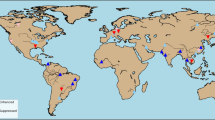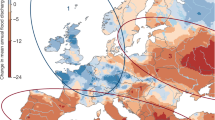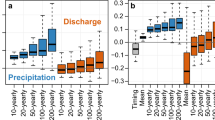Abstract
A succession of storms reaching southern England in the winter of 2013/2014 caused severe floods and £451 million insured losses. In a large ensemble of climate model simulations, we find that, as well as increasing the amount of moisture the atmosphere can hold, anthropogenic warming caused a small but significant increase in the number of January days with westerly flow, both of which increased extreme precipitation. Hydrological modelling indicates this increased extreme 30-day-average Thames river flows, and slightly increased daily peak flows, consistent with the understanding of the catchment’s sensitivity to longer-duration precipitation and changes in the role of snowmelt. Consequently, flood risk mapping shows a small increase in properties in the Thames catchment potentially at risk of riverine flooding, with a substantial range of uncertainty, demonstrating the importance of explicit modelling of impacts and relatively subtle changes in weather-related risks when quantifying present-day effects of human influence on climate.
This is a preview of subscription content, access via your institution
Access options
Subscribe to this journal
Receive 12 print issues and online access
$209.00 per year
only $17.42 per issue
Buy this article
- Purchase on Springer Link
- Instant access to full article PDF
Prices may be subject to local taxes which are calculated during checkout





Similar content being viewed by others
References
Huntingford, C. et al. Potential influences on the United Kingdom’s floods of winter 2013/14. Nature Clim. Change 4, 769–777 (2014).
Matthews, T., Murphy, C., Wilby, R. L. & Harrigan, S. Stormiest winter on record for Ireland and UK. Nature Clim. Change 4, 738–740 (2014).
Pall, P. et al. Anthropogenic greenhouse gas contribution to flood risk in England and Wales in autumn 2000. Nature 470, 382–385 (2011).
2014 Floods: the Numbers (ABI; 2015); https://www.abi.org.uk/Insurance-and-savings/Topics-and-issues/Flooding/Flooding-in-numbers/2014-floods-in-numbers.
Massive rise in Britains flood damage bill highlights the need for more help for flood vulnerable communities says the ABI. ABI (November 11 2015); https://www.abi.org.uk/News/News-releases/2010/11/massive-rise-in-britains-flood-damage-bill-highlights-the-need-for-more-help-for-flood-vulnerable-communities-says-the-abi.aspx.
Cameron ‘suspects’ floods linked to climate change. BBC News (8 January 2014); http://www.bbc.co.uk/news/uk-politics-25656426.
Stott, P. A., Stone, D. A. & Allen, M. R. Human contribution to the European heatwave of 2003. Nature 432, 610–614 (2004).
Kay, A. L., Crooks, S. M., Pall, P. & Stone, D. A. Attribution of Autumn/Winter 2000 flood risk in England to anthropogenic climate change: a catchment-based study. J. Hydrol. 406, 97–112 (2011).
Massey, N. et al. weather@home—development and validation of a very large ensemble modelling system for probabilistic event attribution. Q. J. R. Meteorol. Soc. 141, 1528–1545 (2015).
Taylor, K. E., Stouffer, R. J. & Meehl, G. A. An overview of CMIP5 and the experiment design. Bull. Am. Meteorol. Soc. 93, 485–498 (2012).
Dee, D. P. et al. The ERA-Interim reanalysis: configuration and performance of the data assimilation system. Q. J. R. Meteorol. Soc. 137, 553–597 (2011).
van Haren, R., van Oldenborgh, G. J., Lenderink, G. & Hazeleger, W. Evaluation of modeled changes in extreme precipitation in Europe and the Rhine basin. Environ. Res. Lett. 8, 014053 (2013).
van Haren, R., van Oldenborgh, G. J., Lenderink, G., Collins, M. & Hazeleger, W. SST and circulation trend biases cause an underestimation of European precipitation trends. Clim. Dynam. 40, 1–20 (2013).
Vautard, R. Multiple weather regimes over the North Atlantic—analysis of precursors and successors. Mon. Weath. Rev. 118, 2056–2081 (1990).
Michelangeli, P. A., Vautard, R. & Legras, B. Weather regimes—reccurence and quasi stationarity. J. Atmos. Sci. 52, 1237–1256 (1995).
Yiou, P., Goubanova, K., Li, Z. X. & Nogaj, M. Weather regime dependence of extreme value statistics for summer temperature and precipitation. Nonlinear Process. Geophys. 15, 365–378 (2008).
Barnes, E. A. & Polvani, L. Response of the midlatitude jets, and of their variability, to increased greenhouse gases in the CMIP5 models. J. Clim. 26, 7117–7135 (2013).
Zappa, G., Hoskins, B. J. & Shepherd, T. G. Improving climate change detection through optimal seasonal averaging: the case of the North Atlantic jet and European precipitation. J. Clim. 28, 6381–6397 (2015).
Cattiaux, J. & Cassou, C. Opposite CMIP3/CMIP5 trends in the wintertime Northern Annular Mode explained by combined local sea ice and remote tropical influences. Geophys. Res. Lett. 40, 3682–3687 (2013).
Rodwell, M. J., Rowell, D. P. & Folland, C. K. Oceanic forcing of the wintertime North Atlantic Oscillation and European climate. Nature 398, 320–323 (1999).
Haarsma, R. J., Selten, F. & van Oldenborgh, G. J. Anthropogenic changes of the thermal and zonal flow structure over Western Europe and Eastern North Atlantic in CMIP3 and CMIP5 models. Clim. Dynam. 41, 2577–2588 (2013).
Crooks, S. M. & Naden, P. S. CLASSIC: a semi-distributed rainfall-runoff modelling system. Hydrol. Earth Syst. Sci. 11, 516–531 (2007).
Marsh, T. & Harvey, C. L. The Thames flood series: a lack of trend in flood magnitude and a decline in maximum levels. Hydrol. Res. 43, 203–214 (2012).
Bradbrook, K., Waller, S. & Morris, D. National floodplain mapping: datasets and methods—160,000 km in 12 months. Nat. Hazards 36, 103–123 (2005).
Trenberth, K., Fasullo, J. T. & Shepherd, T. G. Attribution of climate extreme events. Nature Clim. Change 5, 725–730 (2015).
Hansen, J., Sato, M. & Ruedy, R. Perception of climate change. Proc. Natl Acad. Sci. USA 109, E2415–E2423 (2012).
Crichton, D. Flood Risk and Insurance in England and Wales: Are There Lessons to be Learned from Scotland? (Benfield Hazard Research Centre, UCL, 2005).
Managing Climate Risks to Well-being and the Economy (Committee on Climate Change, 2014); http://www.theccc.org.uk/wp-content/uploads/2014/07/Final_ASC-2014_web-version-4.pdf.
Flood and Coastal Erosion Risk Management: Long-term Investment Scenarios (LTIS) 2014 (Environment Agency, 2014); https://www.gov.uk/government/uploads/system/uploads/attachment_data/file/381939/FCRM_Long_term_investment_scenarios.pdf.
Kay, A. L., Davies, H. N., Bell, V. A. & Jones, R. G. Comparison of uncertainty sources for climate change impacts: flood frequency in England. Climatic Change 92, 41–63 (2009).
James, R. et al. Characterizing loss and damage from climate change. Nature Clim. Change 4, 938–939 (2014).
Cramer, W. et al. in Climate Change 2014: Impacts, Adaptation, and Vulnerability. Part A: Global and Sectoral Aspects (eds Field, C. B. et al.) 979–1037 (IPCC, Cambridge Univ. Press, 2014).
Bindoff, N. L. et al. in Climate Change 2013: The Physical Science Basis (eds Stocker, T. F. et al.) 868–952 (IPCC, Cambridge Univ. Press, 2013).
Perry, M. & Hollis, D. The generation of monthly gridded datasets for a range of climatic variables over the UK. Int. J. Climatol. 25, 1041–1054 (2005).
Kistler, R. et al. The NCEP-NCAR 50-year reanalysis: monthly means CD-ROM and documentation. Bull. Am. Meteorol. Soc. 82, 247–267 (2001).
Haylock, M. R. et al. A European daily high-resolution gridded data set of surface temperature and precipitation for 1950–2006. J. Geophys. Res. 113, D20119 (2008).
Peacock, J. A. Two-dimensional goodness-of-fit testing in astronomy. Mon. Not. R. Astron. Soc. 202, 615–627 (1983).
Acknowledgements
The authors thank the climateprediction.net participants whose generous donation of their spare computer processing power has enabled the large model ensembles to be created. Thanks to T. Palmer for suggesting Fig. 2, to S. Kew for assistance with the kernel density estimates, and to M. Tanguy and V. Keller for producing the CEH-GEAR data for 2013/2014 ahead of schedule. We further thank JBA Risk Management Limited for permission to use data derived from their GB Comprehensive Flood Map, based on Astrium digital terrain data. Property locations were derived from AddressPoint data, used with kind permission of Ordnance Survey. N.S., N.R.M., G.J.v.O., R.V., P.Y., A.W., P.A.S. and M.R.A. were supported by the EUCLEIA project funded by the European Union’s Seventh Framework Programme (FP7/2007-2013) under grant agreement no. 607085. N.S. received additional support from the Swiss National Science Foundation. N.R.M., F.E.L.O., S.N.S., W.J.I., A.B., J.M. and D.W. also received support from the NERC HYDRA Changing Water Cycle project. A.L.K., S.M.C. and C.H. were supported by the CEH/NERC National Capability fund. P.A.S., W.J.I. and R.G.J. were also supported by the UK Joint Department for Energy and Climate Change (DECC), Department for Environment, Food and Rural Affairs (Defra) MOHC Climate Programme (GA01101).
Author information
Authors and Affiliations
Contributions
N.S., A.L.K., R.L., G.J.v.O., R.V., P.Y., P.A.S. and M.R.A. designed the study, N.S., A.L.K., R.L., N.R.M., A.B., J.M., J.S. set up and performed model experiments, N.S., A.L.K., R.L., N.R.M., G.J.v.O., F.E.L.O., S.N.S., R.V., P.Y., K.H., C.H., T.L. and J.S. provided analyses and all authors wrote the paper.
Corresponding authors
Ethics declarations
Competing interests
The authors declare no competing financial interests.
Supplementary information
Supplementary Information
Supplementary Information (PDF 18159 kb)
Rights and permissions
About this article
Cite this article
Schaller, N., Kay, A., Lamb, R. et al. Human influence on climate in the 2014 southern England winter floods and their impacts. Nature Clim Change 6, 627–634 (2016). https://doi.org/10.1038/nclimate2927
Received:
Accepted:
Published:
Issue Date:
DOI: https://doi.org/10.1038/nclimate2927
This article is cited by
-
Future extension of the UK summer and its impact on autumn precipitation
Climate Dynamics (2023)
-
When don’t we need a new extreme event attribution study?
Climatic Change (2023)
-
Overstating the effects of anthropogenic climate change? A critical assessment of attribution methods in climate science
European Journal for Philosophy of Science (2023)
-
Nature-based solutions in mountain catchments reduce impact of anthropogenic climate change on drought streamflow
Communications Earth & Environment (2022)
-
Estimation of the probable maximum precipitation (PMP) in the Cheliff semi-arid region (Algeria)
Meteorology and Atmospheric Physics (2022)



